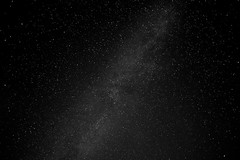Category: Photography
Sunset at Pomar Junction
February 11, 2011 { Photos }
It was (yay) clear but (boo) unseasonably cold on the Central California Coast for my first trip of significance this year, a combined business (Day of JavaScript at Google HQ) and not-business (visiting the fam) junket over a long week at the end of January. This photo is after wine tasting with my mother- and sister-in-law out east of Templeton, Calif., at Pomar Junction.
January, 2011: Two Presentations
February 8, 2011 | 1 comment { Geek, Life, Photography }
Each evening as the pets wax needy, the caffeine wears off, and the house creaks as it cools, I think: I should blog. A pin-snip tightening in the solar plexus; I clamp down and I panic lightly and I know, for one, that I don’t have the margins of energy to tell the whole story of what January is or has been. For two, guilt. The longer I go blogless, the heavier the onus. Even this paragraph has made me lose a kilogram or two of psychic weight. So, in compromise, let’s slide narrower the window of recap to encompass only one subject: two presentations I gave this month.
Photo: The Moon, by David!
November 24, 2010 { Photos }
I’m totally blown away by this photograph that David took through his 6-inch 8-inch Newtonian telescope the other night during an icy, full November moon. The air was quite clear and the shutter speed fast (1/180), well-exposed such that I was able to pull out lovely detail during post-processing. Well done, Mr. Pencil!
Astrophotography: I don’t make a good beginner at things
November 9, 2010 { Books & Learning, Photography }
Techniques of imaging the sky with some sort of camera progress from common sense to PhD within a single sentence. I know because I’ve spent weeks trying to find a conceptual, somewhat layman’s explanation of the basics, and keep getting mired in gearhead, Byzantine Web forums and scientific publications. I lament the absence of any sort of glossy, entry-level book explaining how to take photos of things in space at night, but I’ve come to realize that the reason that no such thing exists is that perhaps it cannot.
Photo: Too Many Stars
November 5, 2010 { Photos }
Easy: taking photos of the night sky with my camera. Hard: correcting them. The skills needed to do this right are not ones I have. I almost don’t want to post this photo. Near Hood River, Ore.
148 seconds on a German Equatorial Mount (GEM). Translation: keeps me from getting star trails. Mostly.
Photo: Ben and I, Fremont Bridge
September 28, 2010 { Photos }
This photo was requested of me yesterday. It’s a pleasure to find it and remember it. It was taken in May of 2001 underneath the Fremont Bridge on Fuji Velvia 50. It’s a 30-second exposure, which I can tell you because 30 seconds is the longest non-bulb exposure my Canon EOS A2 would take. Flash at beginning of exposure, Ben was a real brick, stood really still. I ran in after about 10 seconds and also stood still.
Djúpavík: Possibly the Most Interesting Place I have Ever Been
September 21, 2010 | 3 comments { Photography, Travel }
Emerging from my dazed over-stimulated WOW after several weeks, I can finally process the caliber of the stuff I saw floating around Europe for a month with David. First up is Djúpavík, an almost intolerably photogenic and surreal abandoned fishing village in far northwestern Iceland. To get there you drive along the Arctic Ocean on a tiny road and you feel like you’ve discovered something no one else has ever seen.
Photography: How Birmingham Got Me, Again
September 20, 2010 | 1 comment { Photography, Travel }
This used to be my front door. It’s in Edgbaston, a neighborhood in Birmingham, UK. Birmingham is difficult for me because I like it okay but it does not like me. For one thing, when I lived there, it rained every day. Did I mention that? It is actually not an exaggeration. I got over that, but then when I finally made it back for a “hey, Brum, what’s up?” visit this past June, it pulled a fast one on me.
Photo: My Dad’s Swallow Doretti
July 17, 2010 { Photos }
File this under family/nostalgia. Here’s a really gritty scan of a slide from the late 1970s, showing my Dad’s Swallow Doretti and my mom in front of what appears to be, maybe, the Coast Range west of Portland. According to Wikipedia, only 276 Swallow Dorettis were ever produced, in 1954-55. The car is built on the Triumph TR2 platform. I don’t know what ever became of it.
Photo: Sunset near La Grande Maison, Loire Valley, France
June 27, 2010 { Photos }
Sunset over ripening wheat fields near La Grande Maison, a several-hundred-year-old fortified house converted into a bed and breakfast. This is in the Loire Valley, somewhat near Saumur, France. More photos to come from the trip as I catch my breath upon returning to Portland.
From the Archive
From the archive, a few random posts that you might not have seen before.
- Jan 29, 2008 { Crohn's, Life }
The Continuing Saga - Feb 26, 2008 { Crohn's, Life }
Getting Back to Normal - Jun 25, 2008 { Photography, Travel }
A Few Bonus Photos - Nov 17, 2010 { Books & Learning }
Jupiter Week: Wednesday: Delinquent moons
